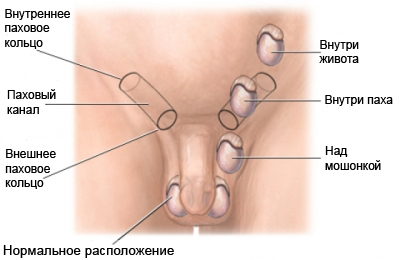Orxopeksija – Orxidopeksija – laparoscopic surgery
Description laparoscopic orhopeksii
Sometimes boys are born with one or both testicles in the abdomen or groin, and not in the scrotum. This is called undescended testicles. Orxopeksija – transfer operations eggs (testicular) in the scrotum. Moşonka – external bag, which contains the testicles.

Reasons for orhopeksii
The procedure is performed for the treatment of undescended testicles, if they do not move down independently. If left untreated undescended, in the future may develop infertility.
Possible complications of laparoscopic orhopeksii
Complications are rare, but the procedure does not guarantee the absence of risk. If you plan to laparoscopic orhopeksiya, you need to know about possible complications, which may include:
- After surgery, the testicle is moved back into the groin;
- Damage to the testicle;
- Bleeding;
- Infection;
- Reaction to anesthesia;
- Injury to surrounding tissues.
How is laparoscopic orhopeksiya?
Preparation for the procedure
The children's doctor and the anesthesiologist will conduct the following:
- Inspection of child;
- Appoint Taking Pictures, blood and urine tests;
- Identify potential risks of anesthesia used.
Tell your doctor about medicines, adopted child or newly transferred them diseases. Some medications before surgery is necessary to cancel.
Before surgery:
- It is necessary to bring toys, books and comfortable clothes for your child, during his stay in the hospital;
- The child must avoid taking food in a certain period of time before surgery. Ask the doctor, when the child has to stop eating and drinking. For children aged up to one year is not recommended to eat after midnight before surgery. Clear liquids (eg, milk, water, clear juices) you need to stop taking the two hours before the procedure.
Anesthesia
Used general anesthesia, which blocks pain and support a child in a sleep state during operation. Introduced in the arm or hand.
Laparoscopic Procedure orhopeksii
Once the child is asleep under anesthesia, the doctor will make small incisions on one or both sides of the groin and abdomen, through which a laparoscope is introduced – thin, long tube, through which the doctor can see the internal organs. First, the physician must detect and investigate egg. In case of a hernia it is sewn.
The doctor then creates a pouch in the scrotum. Testicle (testicles) They will be omitted in the created pouch sewn and bioresorbable thread. The rest of the cuts will be closed seams.
In most cases, a child can go home from the hospital the day of surgery.
How long will laparoscopic orhopeksiya?
1 hour for one testicle.
Laparoscopic orhopeksiya – Will it hurt?
Anesthesia prevents pain during the procedure. After the surgery, the doctor will give painkillers.
Care after laparoscopic orhopeksii
In the hospital
- The child's condition will be monitored, until after anesthesia;
- The nurse will give pain medicine as needed.
Home Care
When the child returns home, Follow these steps:, to ensure the normal recovery:
- Let him painkillers and drugs to prevent infection, as indicated by a physician;
- Minor bleeding is normal. Take care of the incision, as indicated by a physician;
- If your child wears diapers, they need to be changed frequently. For some time, do not wear their child, to provide air access to the surgical site;
- Ask the doctor, when it is safe to bathe the child;
- Play with your child in a calm game. The child can not be tense for several weeks. Also, he could not sit for a long time, or ride a bike for a week after surgery;
- Watch for signs of pain in the child. These may include nervousness, flow problems, Sweating, pale skin;
Be sure to follow your doctor's instructions.
Contact your doctor after laparoscopic orhopeksii
After discharge from the hospital need to see a doctor, if the child has the following symptoms:
- Increasing pressure or pain;
- Redness, allocation, puffiness, pain around the incision;
- The change in frequency of urination, odor, appearance or urine volume;
- Difficulty urinating;
- Signs of infection, including fever or chills;
- Vomiting;
- Abdominal pain;
- Lack of energy;
- Loss of appetite.
